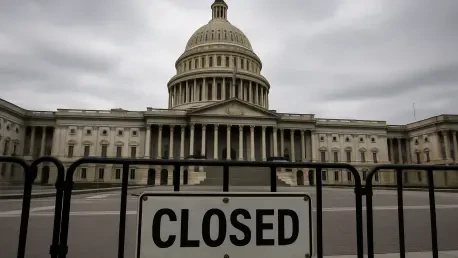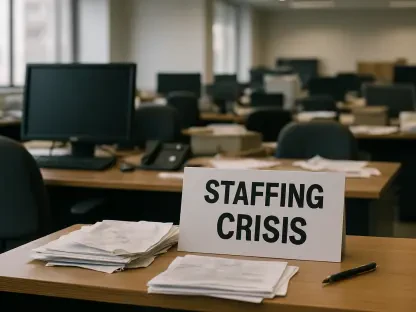The reverberations of a historic 43-day government shutdown, the longest in U.S. history, continue to unsettle thousands of federal employees across various agencies, leaving them in a distressing state of uncertainty about their job status. Despite the government reopening through a temporary funding measure known as a Continuing Resolution, many workers remain in the dark about whether they are still employed or if their layoffs, issued through reduction-in-force (RIF) actions, stand firm. This unprecedented disruption has not only upended professional lives but also inflicted deep personal and financial strain, especially as it coincided with the holiday season. From civil rights officers to diplomats, the lack of clear communication from agency leadership has transformed a bureaucratic challenge into a human crisis, with employees anxiously awaiting resolution while navigating a maze of legal and administrative obstacles.
This lingering chaos touches multiple federal agencies, including the Department of Education, the State Department, and the Small Business Administration (SBA), where employees face a barrage of mixed messages and systemic failures. The emotional toll is palpable, as some workers declined alternative job offers based on fleeting assurances of reinstatement, only to face reversals that deepened their financial insecurity. Beyond the personal impact, the situation reveals broader systemic issues, from legal ambiguities to technical breakdowns, that have prevented a smooth return to normalcy for many in the federal workforce.
Navigating the Aftermath of Disruption
Communication Breakdowns Across Agencies
A pervasive issue haunting federal workers in the wake of the shutdown is the glaring absence of clear communication from agency leadership, leaving employees in a frustrating limbo. Many check their inboxes daily, hoping for an official update on their employment status, only to be met with silence or, worse, contradictory messages that sow further confusion. This problem spans various departments, where the lack of definitive guidance has left staff, from administrative personnel to specialized officers, uncertain whether they are on administrative leave, terminated, or still employed. The frustration is compounded by the fact that even basic inquiries go unanswered, creating a sense of abandonment among those who have dedicated years to public service. This communication void is not merely an inconvenience but a significant barrier to planning their professional and personal futures.
Beyond the silence, there are instances of outright miscommunication that have deepened the crisis for federal employees. In some cases, workers received initial notifications suggesting their layoffs were rescinded, only to have those hopes dashed by subsequent reversals with no detailed explanation. Such inconsistent messaging has led to a profound erosion of trust in agency leadership, as employees grapple with the uncertainty of whether to seek other employment or hold out for reinstatement. The emotional weight of this uncertainty cannot be overstated, as it disrupts not just career trajectories but also family stability, especially for those who faced these upheavals during a financially demanding time of year. The lack of a coherent strategy to address these concerns highlights a critical failure in managing the human side of governmental operations.
Emotional and Financial Fallout
The shutdown’s timing, overlapping with the holiday season, amplified the emotional and financial strain on federal workers, many of whom were already stretched thin by the uncertainty of their job status. Employees describe a rollercoaster of emotions, swinging between hope and despair as they awaited news that could secure their livelihoods. For some, the stress was exacerbated by the need to support families during a period traditionally marked by celebration and spending, turning festive occasions into moments of anxiety over unpaid bills and unclear futures. This personal crisis is a stark reminder of the human cost behind bureaucratic delays, as workers struggle to maintain normalcy in the face of professional upheaval.
Financially, the impact has been devastating for many who relied on the promise of reinstatement to make critical life decisions, such as declining other job offers in anticipation of returning to their federal roles. When those assurances were abruptly withdrawn, the consequences were immediate—lost opportunities and mounting debts became harsh realities. The ripple effects extend beyond individual households, affecting local economies as reduced spending power impacts communities reliant on federal employees. This financial insecurity, paired with the emotional burden of not knowing what comes next, paints a grim picture of the shutdown’s lasting effects, underscoring the urgent need for resolution and support for those caught in this ongoing turmoil.
The Legal and Policy Mess
Unpacking the Continuing Resolution
At the core of the uncertainty facing federal workers is the Continuing Resolution (CR) passed by Congress to temporarily fund and reopen the government after the shutdown, a measure intended to provide relief but instead sparking widespread confusion. This legislative action includes a provision aimed at voiding RIF actions that occurred during the shutdown period, yet its scope remains a point of contention among agencies, unions, and legal experts. The ambiguity lies in whether the CR applies solely to layoffs initiated during the shutdown or extends to those with separation dates falling within that timeframe. This lack of consensus has left thousands of employees in a precarious position, unable to determine if their layoffs are legally voided or still enforceable, while they await official clarification that seems slow to materialize.
The legal gray area surrounding the CR has created a battleground of interpretation, with significant implications for federal workers hoping for reinstatement. Unions and advocacy groups argue for a broader application of the resolution, insisting that it should protect all employees whose layoffs were scheduled or finalized during the shutdown, regardless of when the RIF notice was first issued. In contrast, several agencies maintain a narrower view, asserting that only specific cases fall under the CR’s protections, thus justifying their decision to uphold certain layoffs. This ongoing dispute has stalled progress for many employees, who find themselves trapped in a legal limbo, unable to move forward with career plans or secure financial stability until a definitive ruling or policy is established to resolve these discrepancies.
Agency Interpretations vs. Worker Expectations
The tension between agency interpretations of the CR and the expectations of federal workers has fueled a frustrating standoff, with little immediate resolution in sight for those affected by RIF actions. Agencies such as the SBA have taken a firm stance, arguing that the resolution does not apply to their specific layoffs, and have continued to enforce separation notices despite initial indications of potential reinstatements. This rigid position has clashed with the hopes of employees and their representatives, who believe the legislative intent was to safeguard a wider range of workers from the shutdown’s fallout. The resulting discord has left many feeling betrayed by a system they expected to protect their interests during such a crisis.
Compounding the issue is the lack of transparent dialogue between agencies and their workforce, as differing interpretations of the law are rarely accompanied by detailed explanations or opportunities for appeal. Employee advocacy groups have pushed back, demanding that agencies adopt a more inclusive reading of the CR to reinstate workers and provide retroactive support for the time lost during the shutdown. However, without a unified legal framework or intervention from higher authorities to settle these disputes, the gap between expectation and reality persists. This ongoing conflict not only delays resolution for individuals but also undermines confidence in the government’s ability to manage crises effectively, highlighting the need for clearer policies to prevent such misunderstandings in future disruptions.
Case Studies of Affected Agencies
Department of Education’s Struggles
Within the Department of Education, particularly in the Office of Civil Rights, the aftermath of the shutdown has left employees in a distressing state of uncertainty, with many still awaiting official updates on their employment status months after initial layoffs. Some staff members received RIF notices as early as last spring, while others were informed during the shutdown itself, yet more than a week after the government reopened, no concrete answers have been provided by agency leadership. Even with a federal judge’s injunction pausing certain layoffs and the provisions of the CR in place, the department has been slow to reverse or clarify many of these actions. This inaction has left workers in a frustrating holding pattern, unable to plan their next steps or regain a sense of professional stability.
Adding to the turmoil are technical and administrative hurdles that have further isolated employees from resolution at the Department of Education. Issues such as disabled email accounts and unreturned government-issued equipment have made it nearly impossible for affected staff to communicate with human resources or access critical updates. These logistical failures are more than mere inconveniences; they represent a deeper lack of preparedness and coordination within the agency, exacerbating the sense of abandonment felt by workers. For many, the inability to even log into systems or retrieve personal items symbolizes a broader disconnect, raising questions about how such fundamental breakdowns could persist in a department tasked with significant public responsibilities.
State Department’s Confusion
At the State Department, foreign service officers slated for separation during the shutdown are navigating a similarly chaotic landscape, marked by extended administrative leave with no clear timeline or explanation for its duration. Many of these diplomats had meticulously planned retirements or secured new employment, only to find their arrangements disrupted by the lack of definitive guidance on whether their layoffs are permanent or temporarily paused under the CR. The uncertainty has created a ripple effect, impacting not just their professional lives but also personal decisions tied to relocation or financial planning, leaving them in a state of suspended animation as they await clarity from an agency that seems ill-equipped to provide it.
The confusion at the State Department is further compounded by a series of administrative errors that have eroded trust among affected employees. Misplaced furlough notices sent to personal emails, incorrect paperwork, and other procedural missteps have painted a picture of disorganization, frustrating those who expected a higher standard of professionalism from such a critical agency. These mistakes are not isolated incidents but part of a pattern that has left foreign service officers questioning the reliability of the information they receive. As they grapple with these systemic failures, the broader implication is a diminished confidence in the department’s ability to manage its workforce during crises, highlighting an urgent need for improved processes to prevent such chaos in the future.
SBA’s Communication Whiplash
The Small Business Administration presents a particularly jarring case of communication mishandling, where dozens of employees experienced a devastating reversal of fortunes in the days following the shutdown’s end. Initially, 77 workers were informed that their RIF notices had been rescinded under the provisions of the CR, sparking a wave of relief and hope as they prepared to return to their roles. However, within 24 hours, that decision was abruptly overturned with no detailed justification provided, plunging them back into uncertainty. This sudden about-face not only shattered their expectations but also disrupted critical life decisions, as some had declined alternative job offers based on the initial reinstatement notice, leaving them financially vulnerable.
The emotional and financial impact of this communication whiplash at the SBA cannot be understated, especially given the timing during the holiday season when personal budgets are often stretched thin. Employees describe the experience as a cruel bait-and-switch, with the reversal compounding the stress of an already tumultuous period. Beyond individual hardship, the incident raises serious questions about the agency’s decision-making processes and accountability, as the lack of explanation for such a significant policy shift suggests a troubling disregard for transparency. For those affected, the ordeal underscores a broader failure to prioritize the well-being of federal workers, emphasizing the need for consistent, reliable communication to prevent such damaging missteps in the future.
Reflecting on Systemic Failures
Lessons from Bureaucratic Chaos
Looking back, the aftermath of the 43-day government shutdown exposed profound systemic failures within federal agencies, as evidenced by the persistent uncertainty that plagued thousands of workers long after the government reopened. The lack of cohesive communication strategies across departments like the Department of Education, State Department, and SBA revealed a critical gap in crisis management, where employees were often left to interpret vague or contradictory messages on their own. Administrative errors, from disabled accounts to incorrect notices, further highlighted a lack of readiness to handle the scale of disruption caused by such a prolonged shutdown. These breakdowns were not mere oversights but indicative of deeper structural issues that hindered a swift return to normalcy for the workforce.
Paths to Resolution and Reform
Reflecting on this challenging period, it became evident that actionable steps were needed to address the plight of federal workers caught in the shutdown’s lingering effects. Agencies had to prioritize transparent, consistent communication, ensuring that official updates on job status were delivered promptly and clearly to avoid further confusion. Legal ambiguities surrounding the Continuing Resolution demanded urgent clarification through inter-agency collaboration or higher-level intervention to establish a uniform interpretation that protected more employees. Moreover, investments in administrative infrastructure proved essential to prevent technical failures that compounded worker frustration. Moving forward, these lessons served as a call for comprehensive reform in how government shutdowns are managed, advocating for policies that placed employee well-being at the forefront to mitigate the human cost of future disruptions.









